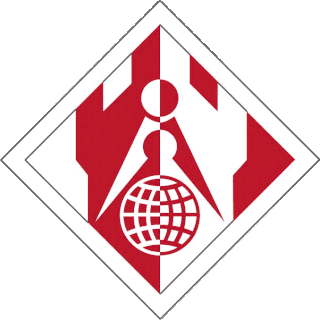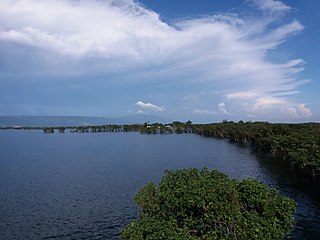Related Research Articles

Bangladesh, officially the People's Republic of Bangladesh, is a country in South Asia. It is the eighth-most populous country in the world and seventh most densely populated with a population of 173,562,364 in an area of 148,460 square kilometres (57,320 sq mi). Bangladesh shares land borders with India to the north, west, and east, and Myanmar to the southeast. To the south, it has a coastline along the Bay of Bengal. To the north, it is separated from Bhutan and Nepal by the Siliguri Corridor, and from China by the mountainous Indian state of Sikkim. Dhaka, the capital and largest city, is the nation's political, financial, and cultural centre. Chittagong is the second-largest city and the busiest port. The official language is Bengali, with Bangladeshi English also used in government.

Bangladesh is a densely populated, low-lying, mainly riverine country located in South Asia with a coastline of 580 km (360 mi) on the northern littoral of the Bay of Bengal. The delta plain of the Ganges (Padma), Brahmaputra (Jamuna), and Meghna Rivers and their tributaries occupy 79 percent of the country. Four uplifted blocks occupy 9 percent and steep hill ranges up to approximately 1,000 metres (3,300 ft) high occupy 12 percent in the southeast and in the northeast. Straddling the Tropic of Cancer, Bangladesh has a tropical monsoon climate characterised by heavy seasonal rainfall, high temperatures, and high humidity. Natural disasters such as floods and cyclones accompanied by storm surges periodically affect the country. Most of the country is intensively farmed, with rice the main crop, grown in three seasons. Rapid urbanisation is taking place with associated industrial and commercial development. Exports of garments and shrimp plus remittances from Bangladeshis working abroad provide the country's three main sources of foreign exchange income.

The United States Army Corps of Engineers (USACE) is the military engineering branch of the United States Army. A direct reporting unit (DRU), it has three primary mission areas: Engineer Regiment, military construction, and civil works. USACE has 37,000 civilian and military personnel, making it one of the world's largest public engineering, design, and construction management agencies. The USACE workforce is approximately 97% civilian, 3% active duty military. The civilian workforce is primarily located in the United States, Europe and in select Middle East office locations. Civilians do not function as active duty military and are not required to be in active war and combat zones; however, volunteer opportunities do exist for civilians to do so.
The Environment Agency (EA) is a non-departmental public body, established in 1996 and sponsored by the United Kingdom government's Department for Environment, Food and Rural Affairs, with responsibilities relating to the protection and enhancement of the environment in England.

The Mekong River Commission (MRC) is an "...inter-governmental organisation that works directly with the governments of Cambodia, Laos, Thailand, and Vietnam to jointly manage the shared water resources and the sustainable development of the Mekong River". Its mission is "To promote and coordinate sustainable management and development of water and related resources for the countries' mutual benefit and the people's well-being".

Sundarbans is a mangrove area in the delta formed by the confluence of the Ganges, Brahmaputra and Meghna Rivers in the Bay of Bengal. Spread across parts of India and Bangladesh, this forest is the largest Mangrove forest in the world. It spans the area from the Baleswar River in Bangladesh's division of Khulna to the Hooghly River in India's state of West Bengal. It comprises closed and open mangrove forests, land used for agricultural purpose, mudflats and barren land, and is intersected by multiple tidal streams and channels. Sundarbans is home to the world's largest area of mangrove forests. Four protected areas in the Sundarbans are enlisted as UNESCO World Heritage Sites, viz. Sundarbans West (Bangladesh), Sundarbans South (Bangladesh), Sundarbans East (Bangladesh) and Sundarbans National Park (India).

Independent University, Bangladesh is a private research university in Bangladesh. It is located in Bashundhara of Dhaka, Bangladesh. Founded in 1993 under the Private University Act, 1992. The university awards bachelor's degrees and master's degrees in a wide variety of subjects within business, humanities, social sciences, information technology, engineering, medicine and space and astronomy.

The Scottish Environment Protection Agency is Scotland's environmental regulator and national flood forecasting, flood warning and strategic flood risk management authority. Its main role is to protect and improve Scotland's environment. SEPA does this by helping business and industry to understand their environmental responsibilities, enabling customers to comply with legislation and good practice and to realise the economic benefits of good environmental practice. One of the ways SEPA does this is through the NetRegs environmental guidance service. It protects communities by regulating activities that can cause harmful pollution and by monitoring the quality of Scotland's air, land and water. The regulations it implements also cover the storage, transport and disposal of radioactive materials.
Pacific Disaster Center (PDC) is an applied science, information and technology center, working to reduce disaster risks and impacts on life, property, and the economies worldwide.

A haor is a wetland ecosystem in the north eastern part of Bangladesh which physically is a bowl or saucer shaped shallow depression, also known as a backswamp. During monsoons haors receive surface runoff water from rivers and canals to become vast stretches of turbulent water.
The Philippines' contemporary water supply system dates back to 1946, after the country declared independence. Government agencies, local institutions, non-government organizations, and other corporations are primarily in charge of the operation and administration of water supply and sanitation in the country.

Bangladesh is faced with multiple water quality and quantity problems along with regular natural disasters, such as cyclones and floods. Available options for providing safe drinking water include tubewells, traditionally dug wells, treatment of surface water, desalination of groundwater with high salinity levels and rainwater harvesting.
Water resources management in modern Egypt is a complex process that involves multiple stakeholders who use water for irrigation, municipal and industrial water supply, hydropower generation and navigation. In addition, the waters of the Nile support aquatic ecosystems that are threatened by abstraction and pollution. Egypt also has substantial fossil groundwater resources in the Western Desert.
Bangladesh is an under-developed nation. Despite rapid economic growth, poverty remains a major issue. However, poverty has declined sharply in recent history. Shortly after its independence, approximately 90% of the population lived under the poverty line. However, since economic reforms and trade liberalization of early 1990s, along with accelerated economic growth since early-2000s, Bangladesh have experienced a dramatic progress in reducing poverty. The remarkable progress in poverty alleviation has been recognized by international institutions. According to World Bank, more than 33 million Bangladeshi people have been lifted out of poverty since 2000; as measured by the percentage of people living on the equivalent of US$1.90 or less per day in 2011 purchasing price parity terms.
Friendship is a needs-driven non-governmental organisation that works in the Char islands and riverbanks of northern Bangladesh, the coastal belt in the south, and as of 2017, the Rohingya refugee camps in Ukhia, Cox's Bazar in the southeast. Established by Runa Khan in 2002, Friendship works to empower people through a sustainable, integrated development approach.

Climate change is a critical issue in Bangladesh. as the country is one of the most vulnerable to the effects of climate change. In the 2020 edition of Germanwatch's Climate Risk Index, it ranked seventh in the list of countries most affected by climate calamities during the period 1999–2018. Bangladesh's vulnerability to the effects of climate change is due to a combination of geographical factors, such as its flat, low-lying, and delta-exposed topography. and socio-economic factors, including its high population density, levels of poverty, and dependence on agriculture. The impacts and potential threats include sea level rise, temperature rise, food crisis, droughts, floods, and cyclones.

Al Karaana is a Qatari village located in the municipality of Al Rayyan. It used to be part of the Jariyan Al Batnah municipality before the municipality was incorporated into Al Rayyan. It is situated around 60 kilometres (37 mi) to the south-west of the capital Doha.

The Ministry of Water Resources is a ministry of the government of the People's Republic of Bangladesh, which formulates all kinds of policies, plans, strategies, guidelines and laws, rules, regulations, etc. for the development and management of water resources and the management and control of the departments under its jurisdiction. This ministry prepares and implements development projects on flood control, irrigation and drainage, prevention of riverbank erosion, delta development, land reclamation, etc. through the construction of barrages, regulators, sluices, canals, embankments, rubber dams, flood control dams, coastal embankments and canals. Excavation-re-excavation provides services such as irrigation, flood control, flood prevention, river bank erosion prevention, land reclamation etc.

Bangladesh, with an area of 147,570 km2, features a flood plain landscape and several river systems throughout the country. This landscape provides the major natural resources of water, land, fisheries, forests, and wildlife. The country currently faces several environmental issues which threaten these resources, including groundwater metal contamination, increased groundwater salinity, cyclones and flooding, and sedimentation and changing patterns of stream flow due to watershed mismanagement. Some of these, such as the changing patterns of stream flow and presence of lead in groundwater, can be directly correlated with human activity and industrial processes, while others, such as cyclones and flooding are naturally occurring issues.

Kabir Bin Anwar is a retired Bangladeshi civil servant. He was the 23rd Cabinet Secretary of Bangladesh Government, serving for a short period of time from 15 December 2022 until he went to post-retirement leave on 3 January 2023. Prior to that, he was Senior Secretary of the Ministry of Water Resources. Kabir is the chairperson of the Board of Directors of Centre for Environmental and Geographic Information Services. He was the 28th President of Bangladesh Administrative Service Association. He is the chairperson of non-profit Issabela foundation, named after his mother.
References
- ↑ "CEGIS Website". cegisbd.com. Retrieved 12 October 2017.
- ↑ "Challenges ahead for Bangladesh". The Daily Star. 18 March 2016. Retrieved 12 October 2017.
- ↑ "Ganges Barrage Project blessing for country". The Daily Star. 29 March 2015. Retrieved 12 October 2017.
- ↑ "The Organization". cegisbd.com. Retrieved 12 October 2017.
- ↑ "GIS map to show locations of all optical fibre cables". The Daily Star. 4 August 2016. Retrieved 12 October 2017.
- ↑ "CEGIS, banglalink sign MoU". The Daily Star. 23 October 2007. Retrieved 12 October 2017.
- ↑ "Balanced use of water must for Bangladesh". The Daily Star. 14 June 2012. Retrieved 12 October 2017.